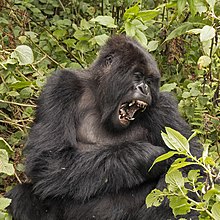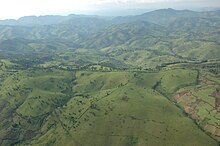Environmental issues in the Democratic Republic of the Congo
Environmental issues in the Democratic Republic of the Congo are the consequence of compounding social and economic problems, including lack of access to clean energy, clearing of lands for agriculture and economic development, and armed conflict. Major environmental issues in DRC include deforestation, poaching, which threatens wildlife populations, water pollution and mining.
A dense tropical rainforest in the DRC's central river basin and eastern highlands is bordered on the east by the Albertine Rift (the western branch of Africa's Great Rift System). It includes several of Africa's Great Lakes.
The civil war and resulting in poor economic conditions have endangered much of this biodiversity. Many park wardens were either killed or could not afford to continue their work. The five
as World Heritage in Danger.Displaced refugees cause or are otherwise responsible for significant
Species and biodiversity loss

The environmental problems associated with the DRC affect its many endemic species of flora and fauna. The DRC has the world's second largest contiguous rain forest after the
Species loss has been cited as a problem in the DRC, brought about or exacerbated by reasons that include deforestation for mining, wood fuel, infrastructure or agriculture, war, illegal poaching and increased consumption of bush meat due to overpopulation and lack of food security.
Deforestation

Between 2000 and 2014 the DRC lost an average of 570,000 hectares (0.2%) of rainforest to deforestation per year, with the highest amount of deforestation coming between 2011 and 2014.[8] Deforestation is the primary cause of biodiversity reduction and species loss globally, through habitat loss and fragmentation.[9] One of the goals of the SDG 15 is to reduce deforestation and encourage reforestation by 2020. The DRC had a 2018 Forest Landscape Integrity Index mean score of 7.56/10, ranking it 36th globally out of 172 countries.[10]
The DRC has Africa's largest rainforest, which is under the threat of deforestation through mining operations, agriculture, infrastructure and wood fuel. In the DRC 94% of wood taken from the rainforest is used for wood fuel, mainly due to poverty, lack of energy infrastructure and the decentralised nature of its population. To mitigate this aid agencies have tried to promote agro-forestry with fast growing trees to avoid over exploitation of the rainforests.[11] Other large drivers of deforestation include mining and conflict, during the Congo conflict deforestation by militia groups was high for wood fuel, small mining operations and illegal logging to fund their operations. However, conversely conflict reduced deforestation for large scale mining due to security instability.[5]
One policy being attempted to reduce the deforestation and increase biodiversity in the DRC is the
Bush meat
Bush meat refers to any meat that is procured from the wild. Overpopulation and continual conflicts in the DRC have led to food shortages, which have therefore increased the use of bush meat. Although data on bush meat use is not extensive, studies estimate 6 million tonnes of animals are taken for bush meat globally each year.[13] What animals are hunted are done so indiscriminately without thought of the importance of certain species that could be ecosystem engineers or keystone species.[13]
Bush meat is an important source of protein for millions in the DRC, especially in rural areas where it makes up 50–70% of meals. For some who cannot afford farmed produce it is a free meal.
Recently the prevalence of hunting for bush meat has declined because of the risk to hunters and butchers from the
Poaching
Poaching for the exotic animal or ivory trade has been a persistent problem for
The introduction of park guards and the implementation of eco-tourism in Virunga National park, a primary habitat for great apes, has allowed the endangered mountain gorilla population to jump over 1000, a 25% rise on 2010 numbers.[20] However, the study indicated that poaching is still an existing problem, with researchers finding 380 snares and park guards continually being ambushed and killed by poachers.[20]
Impact of war
There has been a war in the DRC in different levels of intensity since 1994 when the country was called Zaire.[21] Although what was known as Africa's World War had ended in 2003 the eastern part of the country still has ongoing skirmishes between rebel groups and government forces.[21] No other method has reduced species population so dramatically than conflict, when a militia reached the Garamba National Park in 1997, within three months half of the park's elephants, two thirds of the buffalo, and three quarters of its hippos vanished.[22] The reason conflict is so damaging to wildlife is the increased use of bush meat to feed soldiers, the prevalence of weapons, the lucrative industry of selling exotic animals and ivory as well as the general failure of law and order.[22] According to another study which was taken during the time of the civil war in the Okapi Faunal Reserve, there was a 50% reduction in the abundance of elephants and a vast change in the distribution of them to the more secluded areas of the park.[23]
References
- ^ "Mountain Gorilla | Gorillas | WWF". World Wildlife Fund. Archived from the original on 28 November 2018. Retrieved 20 November 2018.
- ^ "Congo Rainforest and Basin | Places | WWF". World Wildlife Fund. Archived from the original on 30 October 2018. Retrieved 2 November 2018.
- ISSN 0006-3207.
- ^ "Forests, desertification and biodiversity – United Nations Sustainable Development". www.un.org. Archived from the original on 1 November 2018. Retrieved 2 November 2018.
- ^ ISSN 0006-3207.
- ^ Centre, UNESCO World Heritage. "Natural World Heritage in the Congo Basin". whc.unesco.org. Archived from the original on 31 October 2018. Retrieved 2 November 2018.
- )
- ISSN 1748-9326.
- ^ "Impact of habitat loss on species". Archived from the original on 16 November 2018. Retrieved 26 November 2018.
- PMID 33293507.
- ^ "Woodfuel in the Congo forests". Global Forest Atlas. Archived from the original on 26 October 2017. Retrieved 2 November 2018.
- ^ "UN-REDD Programme". UN-REDD Programme. Archived from the original on 19 November 2018. Retrieved 20 November 2018.
- ^ S2CID 18157508.
- ^ "There's Another Side To Bush Meat That Doesn't Get Much Attention". NPR.org. Archived from the original on 19 November 2018. Retrieved 20 November 2018.
- ^ ISBN 978-0-470-69259-2
- ISSN 2456-1878.
- ^ a b Mednick, Sam. "Ebola poses challenges for bush meat in Congo". Philadelphia Tribunal. Archived from the original on 2 December 2018.
- ^ "Elephant Poaching on Rise in Resistance Army Stronghold in Democratic Republic of Congo". Scientific American. Archived from the original on 21 November 2018. Retrieved 18 October 2018.
- ^ PMID 23469289.
- ^ a b Carrington, Damian (31 May 2018). "Mountain gorilla population rises above 1,000". The Guardian. Archived from the original on 11 October 2018. Retrieved 18 October 2018.
- ^ a b "Q&A: DR Congo conflict". BBC News. 20 November 2012. Archived from the original on 7 October 2018. Retrieved 18 October 2018.
- ^ a b Nuwer, R. "War's Other Victims: Animals". The New York Times. Archived from the original on 17 October 2018. Retrieved 18 October 2018.
- PMID 22096529.
